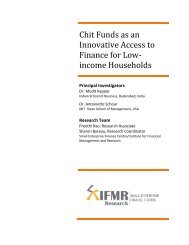Government of India Volume I: Analysis and Recommendations
Government of India Volume I: Analysis and Recommendations
Government of India Volume I: Analysis and Recommendations
Create successful ePaper yourself
Turn your PDF publications into a flip-book with our unique Google optimized e-Paper software.
MICRO-PRUDENTIAL REGULATION<br />
<strong>of</strong> <strong>of</strong>fshore trading venues deny users <strong>of</strong> markets the lowest cost products <strong>and</strong> services.<br />
Conversely, a regulatory race to the bottom where economic stability is sacrificed to increase<br />
competitiveness is equally problematic.<br />
PRINCIPLE 7. The need to take into account the long term implications <strong>of</strong> regulatory actions,<br />
which will include a period <strong>of</strong> at least five years following a regulatory action.<br />
Numerous examples illustrate how micro-prudential regulation can be used in a<br />
manner that reduces failure over a short period <strong>of</strong> time, though with much worse consequences<br />
over a longer period <strong>of</strong> time. For example, regulations that allow conversion <strong>of</strong><br />
a pool <strong>of</strong> illiquid, poorly rated assets into liquid tranches <strong>of</strong> differentially rated securities<br />
(some <strong>of</strong> them highly rated), may reduce the total capital obligations for the institutions<br />
originating these assets, while also seeming to maintain safety <strong>and</strong> soundness. Such<br />
regulation, if not conducted properly with sound alignment <strong>of</strong> incentives, requirement<br />
<strong>of</strong> buffers at different levels, <strong>and</strong> other checks <strong>and</strong> balances, may encourage creation <strong>of</strong><br />
risks that may have consequences years later, perhaps going beyond the regulatory cycle<br />
in which the regulation was notified.<br />
PRINCIPLE 8. The need to minimise the pro-cyclical effects <strong>of</strong> regulatory actions.<br />
Micro-prudential regulation can <strong>of</strong>ten be pro-cyclical, that is, it can amplify business<br />
cycle fluctuations, <strong>and</strong> possibly cause or exacerbate financial instability. In a contraction,<br />
regulatory constraints may bite well before the bankruptcy law does, as financial institutions<br />
regard violating minimum capital requirements as extremely costly. Depending on<br />
how the instruments <strong>of</strong> micro-prudential regulation are used, the extent <strong>of</strong> pro-cyclicality<br />
may vary.<br />
In the framework proposed by the Commission, the primary function <strong>of</strong> micro-prudential<br />
regulation is to think about one financial firm at a time. The task <strong>of</strong> thinking about<br />
overall systemic risk has been placed separately from micro-prudential regulation, precisely<br />
because micro-prudential regulation requires a different perspective. This principle<br />
requires micro-prudential regulators to be aware <strong>of</strong> the extent to which their rules are<br />
pro-cyclical <strong>and</strong> to seek alternative mechanisms which minimise this phenomenon.<br />
PRINCIPLE 9. The requirement that persons who control <strong>and</strong> manage the affairs <strong>of</strong> regulated<br />
persons must share the responsibility <strong>of</strong> ensuring the safety <strong>and</strong> soundness <strong>of</strong> the<br />
regulated persons.<br />
Though the main objective <strong>of</strong> micro-prudential regulation is to maintain safety <strong>and</strong><br />
soundness for regulated persons, the regulator is not the one ultimately responsible for<br />
the safety <strong>and</strong> soundness <strong>of</strong> the regulated persons. That responsibility should stay with<br />
the board <strong>and</strong> management <strong>of</strong> the regulated person. Once a financial service provider is<br />
identified for micro-prudential regulation, consumers, investors <strong>and</strong> other stake-holders<br />
should not perceive themselves to be absolved from responsibility for the safety <strong>and</strong><br />
soundness <strong>of</strong> that institution. Regulation is only an additional set <strong>of</strong> measures that do not<br />
replace the efforts <strong>of</strong> the board <strong>and</strong> management <strong>of</strong> the regulated person. The regulator<br />
should lay out frameworks, which the board <strong>and</strong> management would be responsible for<br />
implementing.<br />
In addition to these principles enshrined in the draft Code, the Commission also recommends<br />
that micro-prudential regulation be conducted in such a manner that there is<br />
balance between a structured <strong>and</strong> a responsive regulatory approach. A very structured,<br />
rules-based approach may bring clarity <strong>and</strong> certainty for regulated institutions, but may<br />
limit the ability <strong>of</strong> the regulator to see risks arising from areas they may not have thought<br />
about sufficiently in time. Also, if an institution is able to find a way to game the rules, the<br />
regulator may not be able to see the problems at all. Regulators could miss the big picture<br />
while being overly dependent on minutiae <strong>of</strong> the framework they have put in place. On<br />
66 FINANCIAL SECTOR LEGISLATIVE REFORMS COMMISSION



